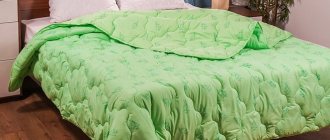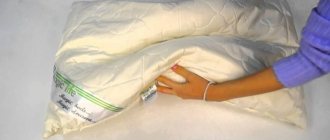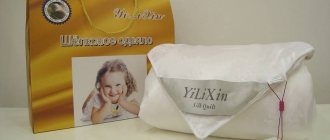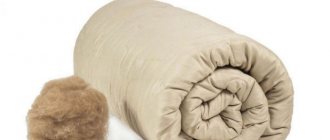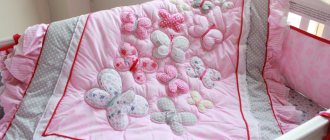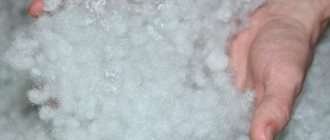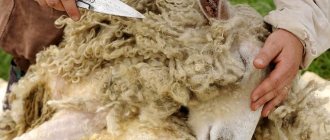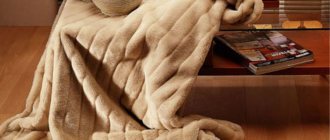Differences and criteria for choosing winter and summer blankets
For a restful, comfortable sleep, every piece of your bedroom wardrobe is important. The product should give warmth and comfort. In addition to the size, filling options and material of the cover, an important role is played by the purpose. The blanket can be summer or winter.
The selection criterion is the filler and its properties. This material is responsible for the degree of warmth. Which blanket filling is best depends largely on the season.
For the winter option, a group of materials is considered suitable: cotton wool, wool, down, cashmere, silk, bamboo. The filler density must be at least 300 g/m2. m. This indicator will provide warmth, but it is also necessary to take into account the physiological characteristics of a person.
For summer options, you can use a wide range of materials. It is important that the density indicator is from 200 to 400 g/sq.m. m. The region of residence matters. If in the southern regions a summer blanket can be replaced with a thin blanket or sheet, then in northern latitudes you will need a warm product.
Manufacturers use markings to indicate the degree of heat in the form of dots.
A blanket with the same filling may have different performance depending on the density of the filling.
There are five groups from 5 to 1 point according to the degree of warmth:
- 5 - winter (very warm), designated •••••;
- 4 (••••) - warm;
- 3 (•••) - all-season;
- 2 (••) - lightweight;
- 1 (•) - summer lung.
Types of fillers
Blankets are classified by type:
- Natural fillers of animal origin.
- Natural herbal.
- Synthetic.
Each group is divided by type of raw material:
- Down of waterfowl.
- Sheep, camel wool, cashmere (mountain goat fluff).
- Cotton.
- Bamboo.
- Silk.
- Synthetic materials (sintepon, holofiber, synthetic fluff, silicone).
- Exotic (algae, eucalyptus, etc.).
An analysis of the characteristics of the fillers will tell you how to choose the right blanket. Let's take a closer look at the pros and cons.
The best blankets for sleeping - manufacturer ratings 2021 -2021
Selection by season
First of all, it is worth noting that it is better to buy a quality product, even if it costs much more. This thing is guaranteed to bring you a restful, healthy sleep and will last longer. So when purchasing a product, it is first of all better to take into account not the price, but the sanitary and hygienic requirements:
- hygroscopicity;
- hypoallergenic;
- breathability;
- thermal conductivity.
For the winter
Which blanket is better to choose and buy for the winter? A good winter blanket, of course, should be light, comfortable and warm. Thus, for the cold season, purchase products that have the ability to retain heat. Therefore, the best for winter are:
- fluff;
- wool;
- padding polyester;
- holofiber;
- cotton wool
All these materials have excellent heat-retaining characteristics.
How to choose the right warm blanket? Heat transfer is indicated on the labels with dots. The lightest is indicated by one dot, and the warmest has five dots.
Summer
For the summer, a light blanket, such as bamboo, would be an excellent option. Which blanket to choose for hot weather to feel pleasantly cool? Silk products are the favorite in this case. They are smooth and have pleasant cooling qualities.
On cool summer nights, wool blends will be indispensable. Despite the presence of wool, they are light, thin and do not cause discomfort.
For all seasons
In an unstable economy, the question of which blanket is best to choose for all occasions becomes relevant. Textile manufacturers have taken care of this too. If it is not possible to have a separate item for each season, then you should choose a universal blanket. It is also suitable for practical people, small apartments and studios where there is no place to store things.
Such products include a double-sided model, one side of which is wool or fur, and the other is fabric. Another interesting solution for all seasons is the double model. It consists of two halves fastened together. This all-season blanket keeps you warm in the winter, and when summer comes, just unfasten the warm half and use the thinner one separately.
Natural
The basis of natural fillers are natural raw materials: plant or animal. All types of materials are environmentally friendly, but some of them can cause allergic reactions. Popular fillers of animal origin are down, wool, and silk.
Plant materials include bamboo and cotton.
Bird fluff
Duck and goose down fillings are affordable, but heavier than eider down. The service life of such blankets is long - from 15 to 20 years. It is comfortable to sleep under them, but this option may not be suitable for people prone to allergies.
Advantages of down fillings:
- light weight;
- high degree of warmth;
- absorb moisture well;
- durability.
The disadvantages include:
- special care;
- allergic reactions.
An ideal winter blanket, it protects well from the cold. However, it is not suitable for people who tend to sweat. Down quickly absorbs moisture, but does not release it well.
Pay attention to the composition. If there is a feather in it, then its content should not exceed 15%, otherwise the product will be prickly and uncomfortable.
In addition to poultry, animal down is used to fill blankets: cashmere goats, merino, camel. The raw materials have good performance properties and high thermal insulation.
Sheep's wool
Eco-friendly material - sheep wool is used in the production of blankets for making blankets and as a filler. Both options are ideal for winter.
Unlike down-filled blankets, wool blankets are less voluminous but heavier. Care is simple, you can wash them in the machine, choosing the “gentle mode”. Unlike duvets made from sheep's wool, they retain dry heat better.
Advantages of the filler:
- easy care;
- thermal insulation;
- air conductivity;
- hygroscopicity;
- massage effect;
- service life 10 – 15 years.
Of the minuses it should be noted:
- sheepskin is attractive to moth larvae;
- ability to cause allergic reactions.
A blanket with sheep wool is suitable for the winter season; blankets made from this material belong to the all-season group.
Camel's wool
Camel wool and down are used as a filler for universal blankets and for making rugs. The material is environmentally friendly. Its properties are similar to sheep's, but the filler has less weight due to the voids in the fiber structure; Warms in winter and protects from overheating in summer.
Advantages:
- light weight;
- seasonality: ability to maintain body temperature;
- wear resistance;
- service life from 15 to 30 years with proper care;
- does not create a greenhouse effect due to good air conductivity;
- hygroscopic: easily absorbs and quickly removes moisture;
- dimensional stability (does not roll off after washing);
- ease of care;
- does not accumulate static electricity;
- unlike sheep wool, it has the ability to repel dirt;
- has healing qualities.
Flaws:
- attractive to dust mites;
- instability to bacteria;
- itchy, needs a quality duvet cover and cover;
- high cost justified by the durability of the product;
- may cause allergies.
When it comes to the question of which blanket is better, camel or sheep, an individual approach is required. Camel wool is lighter, sheep wool is heavy and can cake.
Bamboo
Bamboo blankets appeared relatively recently, but have become popular due to their environmental friendliness and hypoallergenicity. Important! Raw materials processed mechanically are considered natural. The fibers are called “bamboo flax”.
The filler is suitable for autumn, spring and summer. People who get very cold may find such blankets too light and cold.
This fiber has enough advantages:
- hygienic: odorless and does not absorb dust, does not accumulate dust;
- thermoregulation;
- hygroscopicity;
- actively releases accumulated moisture and dries quickly;
- ease;
- free air circulation;
- fiber blankets retain color brightness;
- not electrified;
- hypoallergenic;
- antiseptic properties: promotes the death of harmful microorganisms;
- beneficial effects on the skin.
The disadvantages include:
- low thermal insulation;
- tendency to wrinkle;
- short service life (from 1 to 3 years).
Eucalyptus (tencel, lyocell)
Eucalyptus fiber is an environmentally friendly natural material. A safe organic solvent is used to process wood, while the beneficial properties are preserved.
Filling made from eucalyptus raw materials is used in the production of three types of blankets: universal, summer and winter. They vary in thickness and density:
- universal models - 200 g/sq.m. m.;
- summer - 100 g/sq.m. m.;
- winter - 300 g/sq.m. m.
Eucalyptus filler has many advantages:
- hypoallergenic;
- no odor;
- retains its shape;
- does not accumulate dust;
- not electrified;
- the porous structure of the fibers promotes good air conductivity and hygroscopicity;
- suitable for people with excessive sweating;
- repels dust mites;
- unattractive to bacteria and insects;
- ease of care (machine washable);
- has antibacterial properties;
- due to the content of essential oils it has a healing effect;
- suitable for adults and children;
- service life of 10 years without losing the external attractiveness of the product.
The only disadvantage of eucalyptus blankets is their high cost.
Cotton
Modern cotton filling should not be confused with cotton wool. It is produced by combing out the fibers, bonding them with a special solution to give elasticity and lightness. The raw material is safe for health; non-woven fabrics are made from it.
Advantages of blankets with cotton filling:
- environmental friendliness;
- does not cause allergic reactions;
- ease;
- softness;
- hygroscopicity, ability to remove up to 20% moisture;
- air conductivity;
- strength and wear resistance;
- ease of care;
- affordable price.
There is only one drawback to cotton filling: it is not recommended to wash the product frequently.
Linen
Flax fiber is used to produce bedding. The cost of the blanket is high, but considering the ratio of pros and cons, it is justified. The service life of sleeping items with linen filling is 5 – 7 years.
Pros:
- environmental friendliness;
- strength and wear resistance;
- optimal thermoregulation;
- high hygroscopicity - absorbs up to 12% moisture, quickly removes and remains dry;
- does not absorb odors;
- repels dust;
- does not accumulate static electricity;
- retains its shape;
- neutralizes the electromagnetic field;
- has a beneficial effect on well-being;
- helps strengthen the immune system;
- does not shrink.
Disadvantages of the filler:
- demanding care;
- high price.
Silk
Silk has always been considered a high-status material with high value. Important! High-quality silk blanket is made in China. Silkworm fibers are not suitable for transportation.
The types of fibers are divided into two types:
- Mulberry, considered elite. Lightweight with high thermal conductivity.
- Tussa is a budget option, coarser and heavier than the Mulberry variety.
Benefits of silk fillers:
- softness and tenderness;
- ease;
- hypoallergenic;
- environmentally friendly raw materials;
- increased thermoregulation: warms in winter, cools when it’s hot;
- excellent air circulation;
- high hygroscopicity: absorbs up to 30% of moisture from its own weight, evaporates it and remains dry;
- Seracin protein in the fiber has bactericidal properties;
- repels dust;
- service life 12 – 15 years;
- not electrified.
Disadvantages to consider:
- high price;
- requires delicate handling and care;
- not everyone likes the sliding surface;
- difficult to distinguish from a fake.
Brands of the best
Today, brands such as
- Nature's;
- Togas;
- Kariguz;
- Dargez;
- Ecotex.
Each of them produces truly high-quality products that meet the standards. Domestic producers occupy the majority of the market. This suggests that many of them are able to inspire trust, and it’s not for nothing that they have won a good reputation.
Popular manufacturers of quality blankets for sleeping The variety of bedding products on trading floors sometimes confuses buyers. Blankets, like pillows, come with different fillings and cover materials. In addition, they differ in the degree of warmth.
The first thing you should pay attention to is appearance. The filler plays an important role in the selection criteria, but we also pay attention to what is on top. The material of the cover should be durable, pleasant to the touch, absorb moisture, and allow air to pass through. Natural cotton fabrics have these characteristics: teak, satin, cambric. The sewing technology also differs.
The quilting method is when the filling is sewn to the cover along the entire perimeter of the product with vertical and horizontal seams passing through all layers. This method is suitable for cotton and wool materials.
Let's look at the top popular companies:
- ECOTEX. Exists since 2000. The company has established itself with quality and unique design. Raw materials are checked for the quality of seams and finishing, after which they are packed in branded packaging. A variety of textile options made from cotton, wool, and down will satisfy the tastes of different customers.
- OL-TEX. Certified products of a Russian brand that have received the Quality Mark. Produced on modern equipment from environmentally friendly materials. The wide range of accessories includes a children's line and an adult line in different colors and sizes. In the catalog you can find wool products from the Merino collection, enriched with silver ions from microfibers of the Nano Silver series. The company is known for quality products at reasonable prices.
- Dream Time. A recognizable brand for the production of home textiles. Known for unusual colors of bed linen. Blankets and rugs will also transform the decor of the room. Durable, elegant, made from environmentally friendly materials. There is wholesale production in China and Russia.
- Ascona. Russian company operating since 1990. Known as a manufacturer of mattresses, beds and sleep textiles. Receiving numerous awards, extensive experience, positive customer reviews have made the company recognizable and in demand in many countries. With a volumetric filler, the material of the cover should be stronger.
- AlViTek. Company on the Russian market. Its motto is “Quality at a reasonable price.” Sleep textiles are durable. Comfortable models are made of different fillings: sheep and camel wool, cotton, linen, bamboo, eucalyptus fiber, goose down. In the collections, blankets are divided into warmth retention categories, which makes it easier to choose the right product.
- Nature's. A domestic brand that uses raw materials from farms in the Don region. The filler goes through the stages of washing, drying, and dust removal, resulting in safe textiles. The products have a beautiful appearance and are practical. The variety of fillers pleases customers. Wool, down, cotton, bamboo, and swan's down are used.
- Vasilisa. Brand. The largest manufacturer of textiles made from natural fabrics occupies a leading position in the market. The brand has been awarded the quality mark. Stylish design and variety of products have won trust in Russia and abroad.
- Light dreams. Trademark . Products are made from natural products that meet quality standards. Down products retain their shape and allow air to pass through. The use of bamboo fiber does not cause allergic reactions, and wool fibers have a beneficial effect on joints.
- Verossa. Brand of the stable company NordTex. High quality textiles at an affordable price. Large selection of models made of wool, bamboo, down, artificial fibers. Sleeping accessories are soft and durable. All stages of production are strictly controlled.
Synthetic
Fillers created by the synthesis of chemicals have a lower cost than natural ones. Depending on the type and methods of care, they have different service lifes. Do not cause allergies. Fillings for blankets of different seasons, including universal ones, are made from synthetic fibers.
These fillers are safe for allergy sufferers. Unlike natural fibers, synthetic fibers allow air to pass through worse and are less thermally conductive.
swansdown
Thinsulate, or swan down, is an artificial filler that exhibits properties similar to natural ones (volume and lightness). The difference lies in the low ability to retain heat. Such blankets are off-season.
Benefits of Thinsulate:
- hypoallergenic;
- unattractive to pests and bacteria;
- lightness: the weight of a blanket made from it is 0.5 kg;
- the ability to maintain shape due to the elasticity and resilience of the fibers;
- ease of care.
It is necessary to pay attention to the disadvantages:
- the material is not hygroscopic - its ability to absorb moisture is zero;
- not breathing;
- accumulates static electricity.
Thinsulate blankets are not suitable for people who sweat and should not be used on young children. Due to the properties of the material, there is a risk of overheating.
Polyester fiber
The fibers used to make polyester fillers are produced in four ways. Each class has 4-6 varieties, differing in particle size. The following polyesters are used as fillers:
- Siliconized hollow highly crimped.
- Regular.
Low grade polyester fibers are not suitable for making bedding. Examples of fillers: microfiber, ecofiber, etc.
All materials in this group are similar in properties. The differences between them are not significant. Advantages of polyester fillers:
- ease;
- the ability to retain heat due to the structure of the fibers;
- ease of care;
- elasticity;
- long service life (8 – 10 years).
The disadvantages include the following qualities:
- do not conduct air;
- do not absorb moisture;
- accumulate static electricity.
Holofiber
Holofiber is a polyester filler that is practical and functional. The structure of the fiber is hollow, resembling the properties of a spring. In the line of synthetic materials, it has gained popularity due to its ability to thermoregulate.
The advantages of holofiber include:
- ability to breathe;
- does not cause allergies;
- removes excess moisture;
- has good thermoregulation;
- antistatic properties;
- ease of care;
- fiber elasticity;
- wear resistance;
- does not support combustion;
- lightness, softness;
- affordable price.
Minuses:
- elasticity and lightness are lost over time;
- after washing, loss of shape is possible, the filler begins to cake;
- Some people find it hot to sleep under such a blanket.
Sintepon
Sintepon is a budget filling option. Its service life is 5 – 7 years. Blankets with padding polyester filling have the ability to retain heat and are not afraid of the cold underneath. They remain elastic for a long time.
The advantages include:
- heat-saving properties;
- elasticity;
- health safety (for example, for filling children's sleeping items);
- affordable price.
Minuses:
- cheap samples may use glue that causes allergic reactions;
- low heat and air conductivity;
- not hygroscopic;
- unsuitable for harsh winters.
Thinsulate
Thinsulate was produced as an alternative to natural down. Their properties are largely similar. The second name is synthetic fluff, “swan fluff”. The filler is lightweight and elastic.
But unlike natural down, it is non-hygroscopic, electrified, does not breathe, and its ability to retain heat is much lower.
What to consider before buying a blanket
How to choose a blanket so that it lasts a long time, is practical and comfortable? First you need to determine the seasonality of the sleeping item, then the desired filling. Criteria that are important in this regard:
- Ease.
- Form.
- Softness.
- Case.
- Insulation quality.
- Firmware.
It is worth paying attention to the presence of odor.
Types of tailoring
Thanks to the type of sewing, the blanket gains the ability to retain heat by distributing the filler. Options:
- Quilted is a practical look. Makes it easier to care for the product.
- Karostep is a quilted blanket. The patterned stitch has a beautiful appearance. Blankets quilted in this way wear out faster than classic ones.
- Cassette is an expensive option. Thanks to it, an equal amount of filler is distributed in each cell. This technology prevents caking and knocking.
We take into account the sizes
Which blanket is the best size will be determined by the dimensions of the furniture and individual characteristics. Children's models are chosen for infants and toddlers. For an older child - a teenage or single blanket.
For a person who sleeps restlessly, it is better to choose a double or European standard. The same option is suitable for a married couple. For people who sleep peacefully, a one-and-a-half-size blanket is sufficient.
Cover fabric
The following requirements are imposed on the fabric of the covers: breathability, density, softness and elasticity. The following materials are suitable for this: linen, calico, satin and teak.
You should not choose covers made of synthetic fabrics. In addition to poor air conductivity, they do not have antistatic properties.
Thickness of blankets depending on the season
By density, taking into account the season, they are selected according to the following indicators:
- 100 gsm m. for summer;
- 200 gsm m for all-season models;
- 300 gsm m. for winter.
Quilted or cassette
In this matter, the type of filler plays an important role. For example, a classic stitch is unacceptable for down. It is better to choose the cassette version of the firmware.
Which blanket is best to choose depends on the filling. It is recommended to choose the cassette option for fibers prone to tangling.
Hygiene and size
The modern blanket market is diverse. Thin and dense, wool and bamboo, silk and padding polyester, and also quilted, double-sided and “breathable”: the catalog of any manufacturer is replete with an abundance of characteristics. And so that the buyer does not get confused about them, before going to the store it is worth studying this issue a little.
A good blanket must be chosen correctly in size, choose a safe filler and ask whether it meets basic hygiene requirements. It should be :
- Hygroscopic (a person does not sweat under such a blanket)
- Hypoallergenic (the filler should not cause irritation to the sleeping person)
- Pleasant to the touch
- Breathable
- Warm enough
In order for a sleeping person to feel comfortable under a blanket, it is worth choosing the right size . You need to fit completely under the blanket, and this takes into account the fact that in a dream a person can roll over and change position. In simple terms, legs or arms should not “hang out”. Typically, blankets are conventionally divided into one-and-a-half (for one sleeper) and double (for two people).
However, this division is arbitrary: sometimes a “one and a half” truck turns out to be too small for a large person. And two thin people who prefer to sleep in an embrace may well be comfortable under a small blanket. The standard sizes of one-and-a-half blankets, which are usually available from most manufacturers, are:
• 140 * 205 cm • 150 * 210 cm • 155 * 215 cm • 160 * 220 cm
Double blankets are much larger. Their sizes:
• 170 * 205 cm • 175 * 205 cm • 180 * 210 cm • 200 * 220 cm • 240 * 220 cm
The last two sizes are the most popular. They are also called “European standard”. Even large people feel comfortable under such a blanket. And slender people can generally wrap themselves in them, like in a sleeping bag: many people like it.
